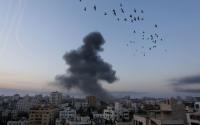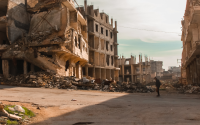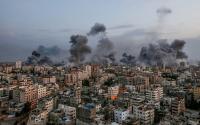25 July 2006missoulian.comPerry Backus
Western wildfires are burning longer and getting bigger as the region's snowpack disappears earlier and temperatures continue to climb, according to a report published recently by Sciencexpress, the online version of the journal Science.To make matters worse - if global warming is the cause and there's good evidence to suggest that it is - the trees going up in smoke will only make matters worse.
The report is the first to document a link between global warming and increased fire intensity in Western forests.Anthony Westerling and his co-authors found there's been a fourfold increase in major wildfires since 1986 in the Western states. Westerling, a climatologist at the Scripps Institution of Oceanography at the University of California, San Diego, looked at major fires - anything more than 1,000 acres - between 1970 and 2003.The group analyzed the geographic location, seasonal timing and regional climatology of the 1,166 recorded wildfires that fit within that scale.The study concluded that the West's fire season was 78 days longer and when fires did take off, they were harder to put out. The duration of large fires increased from an average of 7.5 days to 37 days.Westerling attributed the increase in wildfire activity to a jump in spring and summer temperatures and a mountain snowpack that disappeared anywhere between one to four weeks earlier.Over the 34 years considered in the report, there were five times as many fires in the years when the snow came off early. The fact the snowpack disappeared earlier also opened up new areas farther up the mountain to wildfire.“This is the first report that puts the whole package together,” said Steve Running, a University of Montana ecology professor who served as one of the study's peer reviewers. “This information had not been independently measured before.”While it may not be a surprise for anyone who is paying attention to all the information coming forward on the impacts of global warming, the report does quantify perceptions that wildfires in the West are increasing and climate likely has something to do with it, Running said.Running recently read the Bush administration's Healthy Forest Initiative from front to back.“There's not a word in it either about climate or weather,” Running said. “It's so devoid of the idea of the potential impact of climate that I think it was consciously eliminated.”Instead, the government report suggests increasing wildfires in the West are caused entirely by fuel buildup and a century of fire suppression.“That's the only rationale it gives,” he said. “The Healthy Forest Initiative chose to ignore the impacts of climate change.”Wildfires may be the same bellwether to those living in the West as hurricanes are to residents along southeastern coastlines in terms of waking people up to the challenges of a changing environment, Running said.“It's a wake-up call. Š The report quantifies the same upward trend for wildfires as hurricanes. It's big enough to already be measurable,” he said.The report showed the increase in western wildfires began to accelerate in the mid-1980s - about the same time people began to take an interest as a result of the Yellowstone fires, Running said.“You can go anywhere in the world and people know about Yellowstone Park,” he said. “They also know about the Yellowstone fires.”Westerling's report is especially disconcerting for Montana. It suggests the largest acceleration of wildfires is occurring in higher elevations between 6,000 to 7,000 feet.“That includes a lot of Montana's forests,” Running said. “People always think that lower-elevation ponderosa pine found along the valley bottoms are impacted most by wildfire, but it appears that's not the case.”The higher-elevation stands traditionally have been protected by a slow melting snowpack. Now, as temperatures inch upwards and that snowpack disappears, those stands are becoming more vulnerable to wildfire, Running said.“Fires are getting bigger and bigger and they're marching up the hillside further than they used to,” he said. “These are stands that evolved with a fire frequency of 200 to 300 years. It's a dramatic change.”The idea that things are getting hotter and drier during the summer months isn't always easy to quantify. For the past couple years, the Missoula area has mostly dodged any major wildfire. And over the past three years, western Montana has seen above average amounts of rainfall.“People are certain to ask how can it be wetter throughout the year yet drier in the summer,” Running said. “Even in years when we get a good snowpack, it melts off so fast now days.”This summer is the perfect example. Rivers throughout Montana are currently running at levels typically seen at the end of August. Officials say that's because the peak snowmelt happened three weeks early this spring.Westerling's study showed an average 1.5-degree Fahrenheit temperature rise over the 16 years of the study across the region, which included the Rocky Mountains, the Southwest, the Sierra Nevada and the Northwest.If current trends in temperature gain continue, Running said by 2080 it won't snow at all in Missoula.“If we keep on that trend, in the lifetime of our children it won't snow here at all,” he said. “And that's a conservative estimate. Š From everything that we know globally, things are accelerating.“Montana winters used to be tough and it may be hard for some people not to welcome global warming,” he said. “The flip side to warmer winters is harder summers and this new evidence suggests that more of that is on the way.”Perhaps most worrisome is the potential for wildfires to add to the problem of global warming.Westerling's report said current estimates indicate western forests are responsible for 20 percent to 40 percent of the total carbon sequestration in the United States.Wildfires now add about the equivalent of 40 percent of the fossil fuel carbon emissions to the atmosphere each year.“If climate change is increasing wildfire Š these new sources of carbon emissions will accelerate the buildup of greenhouse gases and could provide a feed-forward acceleration of global warming,” Running said in the conclusion of his review of the Westerling report.





